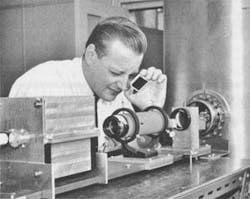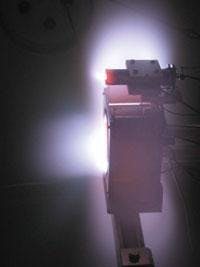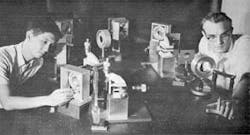Lasers focus on the extraterrestrial
An “applications” report in the Feb. 15, 1965, issue of Laser Focus predicted great promise for lasers in the area of spacecraft propulsion. “Production of ion and electron flows from various materials using a laser as the stimulating element promises to provide a whole new approach to electric propulsion of spacecraft.”
During phase 1 of experiments (funded by the NASA Lewis [now Glenn] Research Center [Cleveland, OH] and under way at the Cornell Aeronautical Laboratory [CAL; Buffalo, NY-which became Calspan Corp. in 1972]) small-diameter wires made from various materials were placed in a vacuum chamber and stimulated with a laser (see figure, top). “From data obtained, CAL researchers are measuring the quantity of ions emitted per unit laser input and the velocity of the emitted ions, from which they compute the total thrust and specific impulse.”
In 1965, the high-power laser laboratory at CAL, had only been in operation for one year, and it was hoped that ion generation through laser stimulation would increase the lifetimes and thrust performance of nascent ion engines by providing an ion source almost completely free of neutral particles.
Since then the importance of fuel-efficient and photovoltaic-powered ion engines for spacecraft propulsion has grown tremendously. Brad King, founder of the Ion Space Propulsion Lab at Michigan Technical University (Houghton, MI), characterized the development of ion propulsion for space flight as similar in import to the transition from propellers to jet engines for aviation. The role of lasers in these systems, however, has been limited primarily to diagnostics in ground testing, while other methods of ion stimulation have gained favor. In arcjet thrusters, for instance, the propellant negotiates a narrow passageway between cathode and anode, and is ionized and superheated when the applied voltage exceeds the breakdown voltage causing an arc to jump from cathode and anode.
In the electrostatic ion thruster design-which provided primary propulsion for Deep Space 1, launched in 1998 and retired in 2001-ionization is stimulated by collisions between atoms in the propellant and electrons that are emitted into the ionization chamber through a hollow cathode (electron gun). A high-voltage grid provides thrust by accelerating the ions in a manner similar to the operation of the grid in a triode. In the Hall effect or plasma thruster design-which provided primary propulsion for the SMART-1 mission, launched in 2003 and scheduled to conclude in 2006-the electromagnetic Hall effect traps electrons that are then used to ionize the propellant and to accelerate the ions to produce thrust (see figure, bottom).
Beaming laser power
Lasers did not take on a thrust-producing role within ion engines, but the idea of beaming energy from both space- and terrestrial-based lasers to, among other things, power spacecraft, continues to draw interest. During the spring of 1999, researchers at Lawrence Berkeley National Laboratory (LBNL; Berkeley, CA) completed a feasibility study for the design of an ignition feedback regenerative amplifier (IFRA) intended to enable a ground-based free-electron laser (FEL) to provide 200 kW of average power. In combination with other technologies (including a 12-m compound mirror with adaptive optics), the FEL system was intended to beam enough power spaceward to boost the 5-kW power levels of communications satellites in geosynchronous orbit by almost an order of magnitude. The feasibility study was related to a commercial project led by Bennett Optical Research (Ridgecrest, CA) and dubbed SELENE, an acronym for space laser energy that is also the name for the Greek goddess of the moon (see Laser Focus World, December 1999, p. 29).
The SELENE name and idea came from a research program at NASA earlier in the decade that investigated beaming laser power to a proposed lunar station and extending the life of communications satellites beyond battery failure, according to Geoffrey Landis, a research scientist at the Glenn Research Center. NASA has also supported research into an optically based power infrastructure in space, using sunlight as the energy source, according to Richard Fork, a professor of electrical and computer engineering at the University of Alabama Huntsville (UAH). His research investigations include the proposed use of high-energy lasers to transmit solar power through free space in the form of coherent light. “Recent work examining the basic physics of high-energy lasers found that such an infrastructure, while prohibitively expensive at this time, could be feasible in the next 40 years,” Fork wrote in 2001 (see Laser Focus World, September 2001, p. 113). Since then their approach has evolved from orbiting thin-disk, solar-powered lasers, to a multidisk composite laser structure, still solar-powered but located on the lunar surface. It coincides with NASA plans for a lunar mission and the idea of beaming laser power from the moon.
Launching lightcraft
Andrew Pakhomov, who supervises the laser propulsion group at UAH (where Werner von Braun and colleagues seeded the NASA ion engine effort after World War II), launched the first international symposium on beam energy propulsion (ISBEP) in 2002. And the fourth symposium was scheduled to be held in Nara, Japan, last month. Beamed energy-propulsion technology exploits a variety of directed energy sources-laser, microwave, and x-ray radiation or relativistic particles and a multitude of propulsive mechanisms: shock waves, ablation, photon pressure, vaporization, and desorption, according to Pakhomov.
In addition to his own research on ablative laser propulsion, Pakhomov collaborates on the development of spin-stabilized, beam-riding disks, dubbed “lightcraft,” with Leik Myrabo, an associate professor of engineering physics at Rensselaer Polytechnic Institute (Troy, NY). Myrabo has so far achieved an altitude record of 71 m with lightcraft propelled vertically on the beam of a ground-based, pulsed, 10-kW carbon dioxide laser (see Laser Focus World, September 2000, p. 29).
Funding for laser propulsion, after falling considerably, has recently surpassed the high interest levels of five years ago, Myrabo said. At that time, Myrabo was collaborating on tests at the White Sands Missile Range (White Sands, NM) with Franklin Mead, project manager at the Air Force Research Laboratory Propulsion Directorate at Edwards AFB. Military interest has returned to laser propulsion as a potential means of affordable access to space, for instance, to launch constellations of nanosatellites (1 to 10 kg), Myrabo said. And significant military successes with high-power lasers in recent times offer hope for actually providing the power levels that will be needed to launch vehicles into orbit.❏
REFERENCE
1. http://powerweb.grc.nasa.gov/pvsee/programs/pvlaser_overview.html
Inside Laser Focus
December 1965
Biomedical effect of laser radiation-A roundup of NEREM papers
Two new ground stations added for Gemini 7 laser experiment
Laser measures range of Explorer XXIX
Prominent authority speaks out on holography
First two-color holographic reconstruction announced
Laser holographic reconstruction ‘caught in the act’
Laser transit simplifies surveying
Laser-Space-age welding process
Phycial aspects of laser materials
The laser patent controversy-or headlines can be misleading
Course on laser technology proposed
Laser danger sign proposed for world use
Plans under way to study use of laser in cancer therapy
More on Gemini 7 laser communications experiment
Ruby laser helps measure gas density
Lasers trim cermet thin-film resistors
Army awards contract for infrared-aimed laser radar
CO2 laser develops 183-watt continuous output
null




